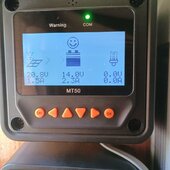Here's the setup:
4 100w renogy 12v panels in parallel
100ah Renogy LiFePo Smart
RVR40a MPPT
700w pure sine inverter (in parallel with the RVR40)
(all of these were purchased within the past month
Here's the issue:
When I measure the PV leads outside the RVR40, I read 22.4v, but as soon as I install them I only read 11-12v across the PV terminals. My battery is at 80% soc, all the parameters are set correctly, all the contacts are good, and this happens whether or not the system is under load or the battery is below/above 50% soc. Because the voltage across the PV terminals is so low, the system won't charge.
Anyone know what could be causing this?
4 100w renogy 12v panels in parallel
100ah Renogy LiFePo Smart
RVR40a MPPT
700w pure sine inverter (in parallel with the RVR40)
(all of these were purchased within the past month
Here's the issue:
When I measure the PV leads outside the RVR40, I read 22.4v, but as soon as I install them I only read 11-12v across the PV terminals. My battery is at 80% soc, all the parameters are set correctly, all the contacts are good, and this happens whether or not the system is under load or the battery is below/above 50% soc. Because the voltage across the PV terminals is so low, the system won't charge.
Anyone know what could be causing this?



